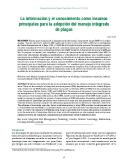| dc.description.abstract | Existen pocos ejemplos de la implementación del manejo integrado de plagas (MIP) en la región Andina. Uno de ellos fue el proyecto MIP-Andes que se llevó a cabo entre 1993 y 1996 con la participación del Centro Internacional de la Papa (CIP) y CARE-Perú. El objetivo de este proyecto fue capacitar agricultores sobre el manejo de Premnotrypes spp. En este artículo se analiza qué sucede cuando el conocimiento campesino entra en contacto con la información técnica sobre MIP, basado en la experiencia del proyecto MIP-Andes. Se propone un modelo para simplificar el proceso de interpretación de la información sobre MIP. Se observaron interacciones formadoras, modificadoras y reforzadoras de conocimiento pero también algunas que generaron confusión, específicamente cuando los agricultores no lograron interpretar apropiadamente la información debido a la forma en que la recibieron. Con respecto a la influencia del conocimiento y de otros factores en la toma de decisiones para adoptar prácticas de MIP se determinó que el conocimiento es un factor esencial, pero no el único que determina la adopción. Se considera que el principal nivel de integración para lograr la adopción del MIP se logra al integrar el conocimiento campesino con la información técnica. Pero también son necesarios otros niveles de integración, como la de prácticas de manejo del cultivo, de la comunidad, de las organizaciones y de las políticas institucionales y gubernamentales. There are few examples of integrated pest management (IPM) implementation in the Andean Region. One of these was the MIP-Andes project, which was carried out between 1993 and 1996, with the participation of the International Potato Center (CIP) and CARE-Peru. The objective of this project was to train farmers in the management of Premnotrypes spp. This paper presents an analysis of what happens when farmers' knowledge interacts with technical information about IPM, based on the experience of the MIP-Andes project. A model is proposed to simplify the process of interpretation of IPM information. Formation, modification and reinforcement of knowledge interactions were observed but some also that generated confusion, particularly when the farmers could not interpret the information appropriately due to the form in which they received it. The influence of knowledge and other factors in decision-making to adopt IPM practices was determined and it is concluded that knowledge is an essential factor but it is not the only factor that determines adoption. In order to achieve the adoption of IPM, integrating farmers' knowledge and technical information is considered to be the main level of integration. However other levels of integration are also required, such as crop management practices, the community, organizations and institutional and governmental policies. | es_ES |


